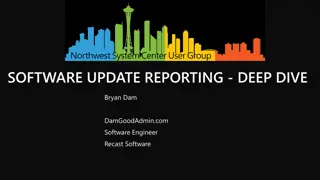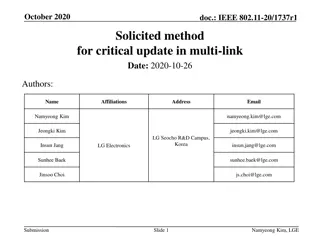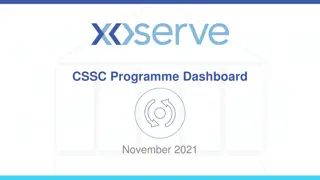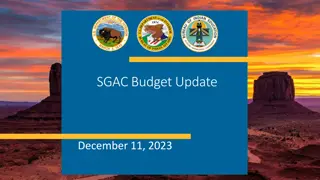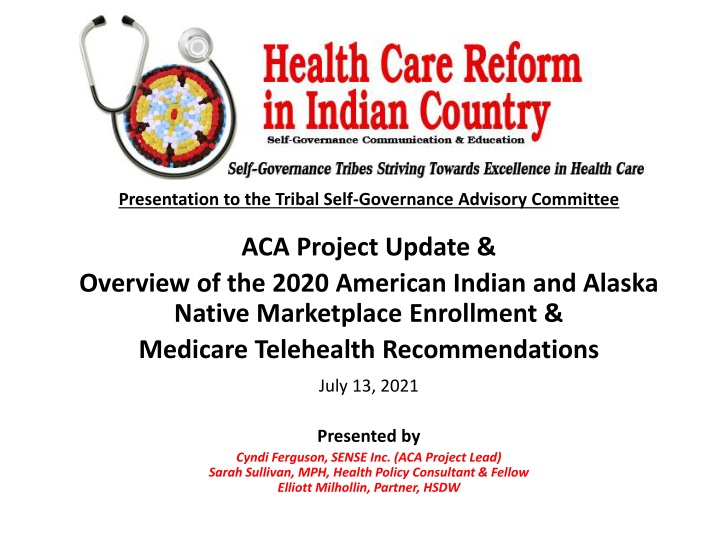
Tribal Self-Governance Advisory Committee ACA Project Update 2020 Overview
Explore the latest updates from the Tribal Self-Governance Advisory Committee, including insights into the 2020 American Indian and Alaska Native marketplace enrollment and Medicare telehealth recommendations. Stay informed about recent project activities, key findings, and enrollment trends.
Download Presentation

Please find below an Image/Link to download the presentation.
The content on the website is provided AS IS for your information and personal use only. It may not be sold, licensed, or shared on other websites without obtaining consent from the author. If you encounter any issues during the download, it is possible that the publisher has removed the file from their server.
You are allowed to download the files provided on this website for personal or commercial use, subject to the condition that they are used lawfully. All files are the property of their respective owners.
The content on the website is provided AS IS for your information and personal use only. It may not be sold, licensed, or shared on other websites without obtaining consent from the author.
E N D
Presentation Transcript
Presentation to the Tribal Self-Governance Advisory Committee ACA Project Update & Overview of the 2020 American Indian and Alaska Native Marketplace Enrollment & Medicare Telehealth Recommendations July 13, 2021 Presented by Cyndi Ferguson, SENSE Inc. (ACA Project Lead) Sarah Sullivan, MPH, Health Policy Consultant & Fellow Elliott Milhollin, Partner, HSDW
Recent Project Activities RECENT TSGAC WEBINARS: Tribal Best Practices in Vaccine Distribution Held March 17, 2021 (105 Participants) Overview of the American Rescue Plan Act and Provider Relief Fund Reporting Held June 23, 2021 (222 Participants) RECENT TSGAC BRIEFING PAPERS: American Indian and Alaska Native Marketplace Enrollment, Including Access to Cost-Sharing Protections (June 15, 2021) Medicare Telehealth Coverage Before, During, and After the COVID-19 Public Health Emergency (July 12, 2021) TSGAC ISSUE TRACKING: Develop and maintain on-going list of TSGAC Project Priority Items (recent list included in today s TSGAC meeting materials and updated regularly). Coordination with TTAG on tracking of priority issues and development of recommendations. 2
American Indian And Alaska Native 2020 Marketplace Enrollment Key Findings In 2020, for the first time the total number of Tribal members and other IHS-eligible individuals exceeded 100,000 (2.7% increase over 2019) in comparison to the 0.3% decrease for the whole U.S. population from 2019 to 2020. For enrollment level on the report run date (January 2021) versus total enrollment any point during the year, there is an overall decline in American Indian and Alaska Native enrollment of 0.9%. BUT this is likely due to the run date and 2020 year-end enrollment likely higher than 2019 year-end enrollment. Total Enrollments of Tribal Citizens and Other IHS-Eligible Individuals: FFM and SBE Marketplaces, 2015-2020 (all enrollments during year) 120,000 99,602 98,950 102,303 98,703 100,000 80,000 60,000 40,000 20,000 0 2015 2016 2017 2018 2019 2020 SBE: Enrolled Tribal Citizen 6258 6874 7566 8801 FFM: Other IHS-eligible 24474 28627 48730 43271 37453 35331 FFM: Enrolled Tribal Citizen 23189 27158 43962 48558 54583 58171 3 FFM: Enrolled Tribal Citizen FFM: Other IHS-eligible SBE: Enrolled Tribal Citizen
Enrolled Tribal Members And IHS Eligibles With Coverage By State For Tribal members, enrollment in the Federal Facilitated Marketplace increase from 2019 to 2020, whereas enrollment of other IHS-eligible individuals declined. Enrolled Tribal Members and IHS Eligibles with Coverage Through the Federally-Facilitated Marketplace; 2015-2020 (as of report run date) 2020 (Jan 2021) 46,239 (+4.2%) 21,511 (-10.2%) 2019 (Nov 2019) 44,369 (+14.2%) 23,965 (-11.7%) 2018 (Oct 2018) 38,867 (+18.6%) 27,149 (+1.1%) 2017 (Nov 2017) 32,778 (+20.7%) 26,841 (-6.2%) 2016 (May 2016) 27,158 (+17.1%) 28,627 (+17%) 2015 (Dec 2015) 23,189 24,474 0 10,000 20,000 30,000 40,000 50,000 60,000 70,000 80,000 Enrolled Tribal Members IHS Eligibles 4
Enrollment in the Federal Facilitated Marketplace (FFM)By State Enrollment gains varied by state, with Oklahoma showing the greatest increase in Tribal member enrollment (14%) and other states showing modest gains, holding flat, or declining. Among the other 37 states with an FFM, enrollment of American Indians/Alaska Natives in Marketplace coverage declined by about 3,900, or 8.8%, from 2019 to 2020. It is important to note, however, that the decrease in overall FFM enrollment of American Indian/Alaska Natives outside of Oklahoma resulted from a significant (15.4%) decline in enrollment of other IHS-eligible individuals; among Tribal citizens, enrollment in these states saw only a slight decrease of only 389 individuals (2.9%). Further, Nevada moved from FFM to SBM in 2020, a change that could account for the slight decrease in the number of Tribal citizens enrolled (November 2019 effective date). 5
Premium Tax Credits And Cost-Sharing Reductions Marketplace continues to provide substantial Federal resources to American Indian and Alaska Native Marketplace enrollees through premium tax credits and cost-sharing reductions. The percentage of Tribal member FFM enrollees receiving the comprehensive Indian-specific cost-sharing protections (through either a zero or limited cost-sharing plan) has increased over time (from 85% in 2015 to 91% in 2020). The percentage of Tribal member enrollees receiving no cost-sharing protections has continued to decline (from 12% in 2015 to 6% in 2020). American Rescue Plan Premium Tax Credit Eligibility Requirement Change: Household income of at least 100% of the federal poverty level (FPL) for 2021 and 2022, instead of between 100% and 400% FPL (requirement prior to 2021). Tribal Sponsorship and American Rescue Plan PowerPoint: CMS Webinar- Tribal Sponsorship and the American Rescue Plan - Health Insurance Marketplace Enrollment for Tribal Citizens and Other IHS Eligibles Important for enrolled Tribal members not to enroll in a health plan with non-Tribal members, otherwise the Tribal members will receive the least comprehensive cost-sharing protections they are eligible for. CMS/CCIIO recently updated HealthCare.gov to help educate families with both Tribal members and non- Tribal members to determine which plan(s) they should enroll to maximize cost-sharing protections. Through TTAG advocacy efforts, a pop-up text box appears in the Marketplace application with benefit information 6
Medicare Telehealth Findings Prior to the COVID-19 PHE: Social Security Act gives the Secretary of HHS discretion to add services to the Medicare telehealth benefit. However, it generally does not allow reimbursement for services provided in a patient s home and there are the following restrictions: 1. The types of providers that may provide Medicare telehealth services; 2. Limits Medicare telehealth services to rural areas; 3. Requires that the patient be in the facility (the "originating site") to receive services with the limited exception of certain end stage renal disease and substance use disorder services; and 4. CMS regulations required an "interactive" telecommunications system, which it defined to require two-way, audio-visual, real-time equipment and to exclude the use of telephones. During the PHE, CMS provided the following flexibilities: 1. 140 services were added to the Medicare telehealth benefit (only 9 Medicare telehealth services were made permanent); 2. Temporarily rescinded the geographic restrictions ( rural restriction ) to allow the benefit to be available outside of rural areas; 3. Temporarily withdrew the site-of-service restrictions so patients could receive telehealth services in their homes or another remote location; 4. Expanded providers that could deliver Medicare telehealth services (Nurse Practitioners, Clinical Nurse Specialists, Physician Assistants); 5. Permitted certain services to be delivered using audio-only equipment, and allowed telephones with audio and visual capabilities to be used for any Medicare telehealth services; 6. Increased access to Medicare reimbursable communications-based technology services, expanding remove evaluation and virtual check-in flexibilities; and 7. Authorized certain provider direct supervision requirements for services provided through a supervising practitioner using interactive audio-video real-time communications technology. 7
Medicare Telehealth Advocacy Recommendations There remains a need to advocate for the following measures to ensure Indian health programs can provide patients the care they need through telehealth and communications-based technology: 1. Congress removing geographic and site of service restrictions on Medicare telehealth services; 2. Congress expanding the types of providers that may bill for Medicare telehealth services; 3. Congress allowing facilities to collect a fee when they are coordinating telehealth visits for patients in their homes; 4. CMS permitting audio-only telecommunications systems to be used to deliver Medicare telehealth services, including audio-only telephones and two-way radios; 5. CMS ensuring that Medicare reimburses Indian health care providers for telehealth services at the OMB rate; 6. CMS permanently expanding, in consultation with Tribes, the types of services eligible for Medicare telehealth reimbursement; 7. CMS permanently expanding, in consultation with Tribes, the availability and sustainability of virtual check-ins and e-visits, including allowing them for new patients; and 8. CMS permanently authorizing direct supervision requirements for services incident to a physician's services to be fulfilled using real-time interactive audio and video technology. 8
Questions and Input Project Team Cyndi Ferguson, SENSE Incorporated Email: cyndif@senseinc.com Sarah Sullivan, Health Policy Consultant/Fellow Email: sksullivan16@outlook.com Elliott Milhollin, Partner, HSDW Email: EMilhollin@hobbsstraus.com 9


